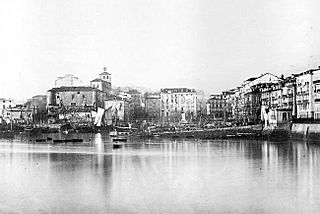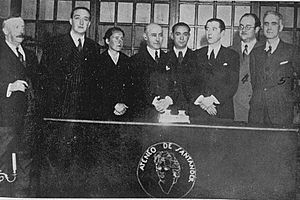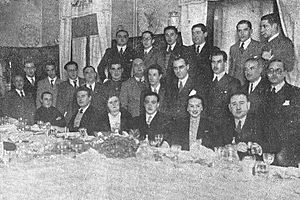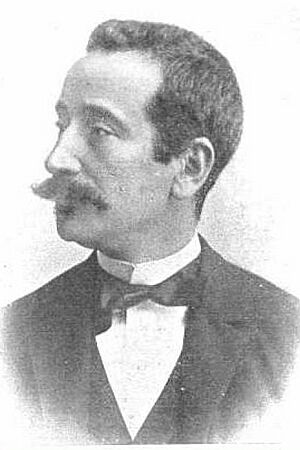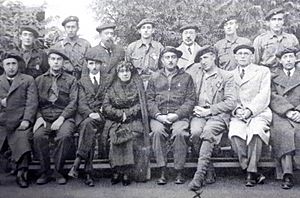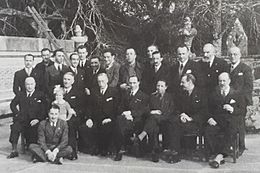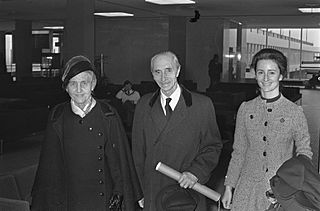Ignacio Romero Raizábal facts for kids
Quick facts for kids
Ignacio Romero Raizábal
|
|
|---|---|
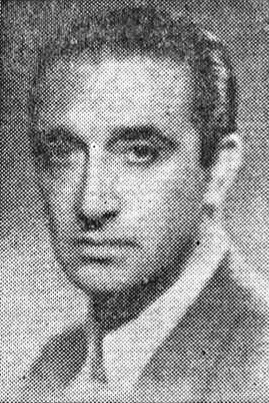 |
|
| Born | 1901 Santander, Spain
|
| Died | 1975 Santander, Spain
|
| Occupation | Dentist |
| Known for | Writer |
| Political party | Carlism |
Ignacio Romero Raizábal (1901-1975) was a Spanish writer and a Carlist activist. Carlism was a traditional political movement in Spain. In the 1930s, he became known as a poet in Cantabria. Later, during the early Francoist era, he was known across Spain for his novels and history books. He published about 35 books in total.
In the 1930s, he led a Traditionalist magazine called Tradición. After the Spanish Civil War, he wrote for Carlist newspapers. These included El Pensamiento Navarro and the monthly magazine Montejurra. He did not hold many political jobs. However, he was briefly a secretary to the Carlist leader, Don Javier. He was also a key person in spreading Carlist ideas. From the early 1960s, he tried to find a middle ground in the Carlist movement.
Contents
Early Life and Family History
We don't know much about Ignacio Romero's early family history. His father, Justo Romero Magro, was born around the 1870s. He died young in the late 1900s. Justo was a dentist. In the 1890s, he was said to have worked for the Spanish royal family in Madrid.
In 1896, Justo married Josefa Raizábal Legorburu (who died in 1941). She was from Santander. Her father, Ramón Raizábal, was also a well-known dentist and professor. He suggested that Justo move to Santander so they could work together. Justo and Josefa settled in Santander. After Justo got his dental license in 1897, he opened his own dental office.
Justo and Josefa had four children. Their first son, Ignacio Romero Raizábal, died in 1899 when he was 9 months old. Their younger son was given the same name. Their oldest daughter, María de los Angeles, married in 1927. Her sister Pilar married in 1932. Pilar was killed during the revolutionary events in Santander in December 1936.
After Justo died, his wife Josefa took over the dental office. She was one of the first women to practice dentistry. She even attended scientific meetings. The children grew up in a very religious home. Romero's grandfather was a Franciscan tertiary. His aunt became a nun in the Carmelite order.
We don't know much about Romero's early schooling. In the early 1920s, he moved to Madrid. He studied at the dental school of Universidad Central. He graduated in 1925. He also completed his required military service. He worked as an assistant to a famous dentist, Florestán Aguilar Rodríguez. Later, he returned to Santander and opened his own dental practice by 1928. He worked as a dentist until 1974.
In 1931, Romero married María Rosa Arche Aguirre (who died after 1974). She was from La Cavada, near Santander. Her father was a local landowner. Ignacio and María Rosa had two sons. Their first son, Ignacio Romero Arche, died in 1936 at age 4. Their younger son, Carlos Romero Arche, did not become a public figure.
A Life of Writing
Ignacio Romero started writing plays while he was still in college. In the late 1910s and early 1920s, he read his poems at Catholic clubs. Most of his poems were about religious topics. In 1924, he won his first local poetry awards. That same year, one of his poems appeared in a national newspaper.
In 1925, Romero published his first poetry book, Un alto en el camino. In 1928, he published Montón de besos. This book was a small edition for his friends. Other books followed, like La novia coqueta (1928) and Los tres cuernos de satanás (1929). These books were mostly about Christian and love themes. They had a calm and popular style.
His book Boinas rojas (1933) turned to historical themes, focusing on loyalty and bravery. He returned to a lighter, lyrical style in Rosario de amor (1934) and El cancionero de la Novia formal (1935). The events of the Spanish Civil War led to books with religious and patriotic feelings. These were En el nombre del Padre (1936) and Cancionero carlista (1938). The last one was his most popular poetry book and was printed three times.
In the late 1930s, Romero stopped writing poetry and started writing prose. In 1938, he published his first and most famous novel, La promesa del tulipán. This book is about a pleasure-loving person who changes and joins the Carlist fighters called Requetés. He finds happiness, including in love. He wrote more prose later, like Alma en otoño (1944) and Inés Tenorio (1947). The latter was a historical version of the famous Don Juan story.
Almas distantes (1949) featured two artists dealing with a huge disaster, the great fire of Santander. Como hermanos (1951) again explored the wartime past. El príncipe requeté (1965) was a true story about the Civil War actions of the Carlist prince, Gaetano Borbón-Parma. To avoid problems with the Francoist government's censorship, Romero wrote it as a fictional story.
Besides poems and novels, Romero also wrote factual and essay-style works. His first was Boinas Rojas en Austria (1936). It covered his trip to the funeral of the Carlist leader Don Alfonso Carlos. Regalo de la boda (1939) was a collection of his earlier articles from the Tradición magazine. La paloma que venció a la serpiente (1943) was a set of essays about the Cristero war in Mexico. Sendero de luz (1948) and A la hora de la Salve (1950) were about religious topics.
Heroes de romance, 25 hombres en fila (both 1952), and Era un monje perfecto (1954) were attempts at understanding people's minds. They contained short descriptions of people connected to Carlism or religion. Altar y trono (1960), re-released in 1968 as El carlismo en el Vaticano, tried to show the relationship between Carlist kings and the Vatican. His last book, El prisionero de Dachau 156.270 (1972), was a collection of essays praising Don Javier and his experiences during World War II.
Working as a Journalist
Romero's career in journalism began in the 1920s. His poems first appeared in local newspapers in Cantabria. Then they were published in the national Integrist newspaper El Siglo Futuro. Around 1930, he started publishing poetry in a literary magazine called Revista de Santander.
His biggest project began in 1932. He and some friends decided to start a serious Traditionalist magazine. It was meant to be "more about teaching than informing." This magazine was called Tradición. It was published twice a month in Santander, with Romero as its director. From 1933, the magazine was published by the Carlist organization in Cantabria. From 1935, it became an official Carlist publication.
About 50 issues were printed until August 1935. Romero remained its editor-in-chief until the end. He kept the magazine's content very high-level. He wrote for almost every other issue. He avoided heated political debates. Instead, he focused on literature, the history of Traditionalism, and praising the Carlist royal family. It's not clear why Tradición stopped publishing in mid-1935.
From 1936 to 1939, Romero published fewer articles. These appeared in various newspapers. At first, they included the Falangist newspaper Labor. Later, they were only in Traditionalist newspapers that were allowed after the unification. These included El Pensamiento Navarro from Pamplona and El Pensamiento Alavés from Vitoria.
During the early Francoist era, his name stopped appearing in newspapers. Some say he was on the editorial board of the Catholic newspaper Ya, but this is not confirmed. In the 1950s, his articles appeared sometimes in El Pensamiento Navarro or El Correo Catalán. These articles were usually about literature or history.
In the 1960s, the Carlist movement changed its approach to the Franco government. This led to some new Carlist newspapers appearing. Romero started writing for them. The most important was the magazine Montejurra, where he became a very active writer. He wrote almost only about history. Romero's articles also appeared in smaller party magazines, like Azada y asta and Esfuerzo común. For Esfuerzo común, a serious, left-leaning magazine, he even joined the editorial board in the early 1970s. It's not clear if he fully agreed with its ideas.
His Role in Carlism
Ignacio's father, Justo Romero, was connected to Integrism. Ignacio followed this political view. In the early 1920s, while studying in Madrid, he was a member of the Integrist Youth of Madrid. In the mid-1920s, he wrote a poem praising the late Integrist leader, Ramón Nocedal.
There is no record of his political actions until the very end of the monarchy. In the local elections of April 1931, he ran as a "monarchist" and "Catholic" for the Santander town hall but lost. In May 1931, after the republic was formed, he refused to swear loyalty to the new government. As a reserve second lieutenant, he was removed from the military list.
At this time, the Integrists, who had separated from Carlism in the 1880s, were rejoining the movement. Romero did the same. In late 1931, he attended a Traditionalist dinner. This event was a tribute to the Integrist journalist, Manuel Senante.
In the early 1930s, Romero began to be seen as a Carlist expert on culture. This was partly due to the launch of Tradición in 1932, which was his own idea at first. However, the release of his poetry book Boinas rojas in 1933 had a much bigger impact. This book praised the Carlist military actions. It quickly made Romero a top Carlist poet.
After another former Integrist, Manuel Fal Conde, became the political leader of the Carlist movement in 1934, Tradición became the official voice of the party's ideas. Romero reportedly joined this council himself. He started traveling around the country. For example, Romero gave a speech at a large Carlist gathering near Seville. He sometimes showed extreme enthusiasm. For example, his 1934 article about the Carlist leader Alfonso Carlos was dated "April 17 of the 101st year of the Carlist Era."
He named his newborn son Carlos in honor of the Carlist king. Romero met the elderly king personally when he spent winters in southern France, near the Spanish border. It's not clear if Romero took part in party strategy discussions. However, his articles showed a desire for "Catholic unity." They sometimes had a hidden anti-republican tone. Before the 1936 elections, Romero used his writing to support his fellow Cantabrian Carlist, José Luis Zamanillo.
During the Spanish Civil War
It's not clear if Romero was involved in the Carlist plans for a rebellion in 1936. He was busy with his oldest son's health. His 4-year-old son died on July 13, 1936. The funeral was one day before the coup began. We don't know where Romero was during the first few weeks of the conflict. In early September, the Santander police demanded he report to the station or be declared a rebel. Later that month, he was in Burgos, in the Nationalist zone. But his wife and other family members were still in Republican-held Cantabria.
Romero was not part of the Carlist wartime leadership. However, in early October 1936, he went with top party leaders. They traveled from Spain through France and Switzerland to attend the funeral of Don Alfonso Carlos in Vienna. His written account of the journey was published later that year. It was also an attempt to praise Fal Conde. This account was quite popular and was re-issued in 1938.
Either in October 1936 or soon after, Romero became secretary to the new Carlist leader, Don Javier. Don Javier lived in Saint-Jean-de-Luz, France. In this role, Romero attended a meeting in February 1937 in Ínsua, Portugal. There, the party leaders discussed how to deal with pressure from the military to unite political groups. Records from this meeting do not show him as a main speaker. In the summer of 1937, as Don Javier's secretary, he spoke with many people sent from Spain, like Eladio Esparza. Some sources say he also served as secretary to Gaetano Borbón-Parma. Other accounts suggest he only interviewed the prince and helped him travel across northern Spain.
Romero worked at Don Javier's office in Saint-Jean-de-Luz for about a year. It's not clear if he returned to Santander in late 1937 after the Nationalists took control of Cantabria. As late as July 1938, he appeared as a witness in a Bordeaux trial. This trial was for a Republican militia commander from Santander, Manuel Neila, who was caught in France. Romero wrongly claimed that the defendant was responsible for the death of his mother and two sisters. In fact, his mother and one sister survived the war. Also in 1938, with the approval of Franco's censors, he published the poetry book Cancionero carlista and his famous novel, La promesa del tulipán. Both books celebrated the Carlist military efforts during the war.
During Franco's Rule
There is no information about Romero's involvement in Carlist groups during the early years of Franco's rule. Even his writing, except for Héroes de romance (1952) about the requetés, was mostly about religious topics or distant historical events. We don't know how he felt about the change in Carlist strategy. This included the removal of Fal Conde and a new, more peaceful approach adopted by the movement in the mid-1950s.
However, he stayed in touch with many important people, including Don Javier. He slowly became involved in efforts to bring Don Javier's son, Prince Carlos Hugo, to Spain. Romero saw Carlos Hugo in a positive way. He described him as "very smiling and affectionate, as is normal for the Bourbon-Parmas." But he was a bit unsure about the media strategy used by the prince's young advisors. In 1962, Romero went with Carlos Hugo to El Pardo before his meeting with Franco. In the early 1960s, Romero noticed that the prince's staff created a barrier around him. But he thought this was necessary for the new times. He saw the young activists taking over top Carlist positions as a welcome "new wave of Carlism."
The years 1963-1964 saw a conflict between the young Carlists, who had new ideas, and the older traditionalists. Romero had to choose a side when the supporters of Carlos Hugo, called huguistas, tried to remove his old friend Zamanillo from the party. He supported Zamanillo and spoke against a harsh pamphlet by Melchor Ferrer. But he could not stop Zamanillo's expulsion. He also had growing doubts about what he saw as the huguistas' clumsy tactics against Franco. In 1964, he complained that it caused them to lose opportunities. At one point, he even considered joining the breakaway RENACE group. But in the end, Romero chose to remain fully loyal to his king.
In the late 1960s, Romero was one of the few Traditionalist figures left in the top Carlist ranks. Most others had left or were pushed aside. He continued to publish traditional, historical articles in party magazines that were becoming more progressive. He even served on the editorial board of Esfuerzo común, a magazine for the progressive Carlists. One source says he was a speaker at the 1967 Montejurra rally, but other sources disagree. At the 1968 Montejurra gathering, Romero acted as a mediator between two groups. The traditional-minded people from Santander tried to attack the progressives. In the early 1970s, he remained loyal to the royal family. This was despite repeated warnings about their "Carlism-Leninism" (a mix of Carlism and communist ideas). Romero saw Zamanillo's attempt to create a different Carlist fighter group as a betrayal. His last book, El prisionero de Dachau (1972), was a tribute to Don Javier and his family.
See also
 In Spanish: Ignacio Romero Raizábal para niños
In Spanish: Ignacio Romero Raizábal para niños


